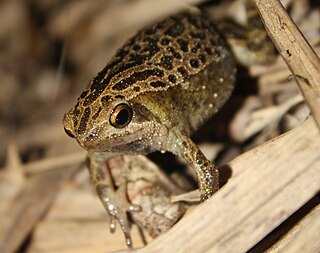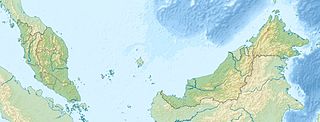
The International Union for Conservation of Nature (IUCN) Red List of Threatened Species, founded in 1964, is the world's most comprehensive inventory of the global conservation status of biological species. It uses a set of precise criteria to evaluate the extinction risk of thousands of species and subspecies. These criteria are relevant to all species and all regions of the world. With its strong scientific base, the IUCN Red List is recognized as the most authoritative guide to the status of biological diversity. A series of Regional Red Lists are produced by countries or organizations, which assess the risk of extinction to species within a political management unit.

A booby is a seabird in the genus Sula, part of the family Sulidae. Boobies are closely related to the gannets (Morus), which were formerly included in Sula.

Kalophrynus is a genus of microhylid frogs. It is the only genus in the subfamily Kalophryninae. The species in this genus are found in southern China, in Southeast Asia to Java and Philippines, and in Assam, India.

The black-spotted sticky frog is a small frog with a black spot just in front of each of its hind legs. It releases a sticky substance when threatened, thereby making it an unpleasant meal for predators, allowing it to escape from harm.

Kalophrynus interlineatus, commonly known as the spotted narrow-mouthed frog, is a species of narrow-mouthed frog found in India and South East Asia including Hong Kong.

A species that is extinct in the wild (EW) is one that has been categorized by the International Union for Conservation of Nature as known only by living members kept in captivity or as a naturalized population outside its historic range due to massive habitat loss.
Kalophrynus baluensis is a species of frog in the family Microhylidae. It is endemic to Mount Kinabalu in Sabah.

Kalophrynus eok is a species of frog in the family Microhylidae. It is endemic to Borneo and currently only known from its type locality in the Kelabit Highlands of Sarawak, Malaysia, but presumably, it also occurs in the adjacent Kalimantan, Indonesia. The specific name eok is Kelabit for "tiny" and refers to the small size of this species. Common names eok sticky frog and small Bario sticky frog have been coined for it.
Kalophrynus heterochirus is a species of frog in the family Microhylidae. It is found in Indonesia and Malaysia. Its natural habitats are subtropical or tropical moist lowland forests, subtropical or tropical moist montane forests, intermittent freshwater marshes, and heavily degraded former forest. It is threatened by habitat loss.
Kalophrynus intermedius is a species of frog in the family Microhylidae. It is endemic to Borneo and is found in Brunei, south-central Sarawak (Malaysia), and Kalimantan (Indonesia). Common names intermediate sticky frog, Sarawak grainy frog, and Mengiong sticky frog have been proposed for it.
Kalophrynus menglienicus is a species of frog in the family Microhylidae. It is known from the vicinity of its type locality in Menglian County in southern Yunnnan, China, and from northern Vietnam; it is likely to occur in adjacent Myanmar and northern Laos. Common names Menglien grainy frog, Menglien narrow-mouthed frog, and Menglien dwarf sticky frog have been coined for this species, in reference to the type locality, as is the specific name menglienicus.
Kalophrynus minusculus is a species of frog in the family Microhylidae. It is endemic to Indonesia and occurs on extreme western Java and on the southeastern tip of Sumatra. It is a relatively small frog, as suggested by its specific name minusculus and vernacular names small sticky frog and dwarf sticky frog.
Kalophrynus nubicola is a species of frog in the family Microhylidae. It is endemic to Sarawak in Malaysian Borneo and is only known from the Gunung Mulu National Park. The specific name nubicola means "dwelling in cloud". Common names blue-spotted sticky frog and mossy-forest sticky frog has been coined for this species.
Kalophrynus palmatissimus is a species of frog in the family Microhylidae. It is endemic to Malaysia. Its natural habitat is subtropical or tropical moist lowland forests. It is threatened by habitat loss.
Kalophrynus punctatus is a species of frog in the family Microhylidae. It is found in Indonesia and possibly Malaysia. Its natural habitats are subtropical or tropical moist lowland forests and intermittent freshwater marshes. It is threatened by habitat loss.
Kalophrynus robinsoni is a species of frog in the family Microhylidae. It is endemic to Pahang in central Peninsular Malaysia. The specific name robinsoni honours Herbert C. Robinson, a British zoologist and ornithologist. This poorly known species has not been reported since 1922.
Kalophrynus subterrestris is a species of frog in the family Microhylidae. It endemic to Borneo where it is known from Sabah and Sarawak (Malaysia), although it is also presumed to be present in Kalimantan (Indonesia) and Brunei. Common names burrowing grainy frog and Labang sticky frog have been coined for this species.

Kalophrynus yongi is a species of frog in the family Microhylidae, also known as the Cameron Highland sticky frog. It is endemic to Peninsular Malaysia and is only known from its type locality near the top of Gunung Brinchang, in the Cameron Highlands, Pahang state. The specific name yongi honours Dr. Yong Hoi-Sen, a zoologist from the University of Malaya.







